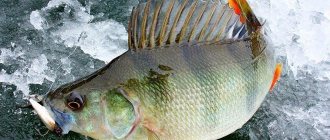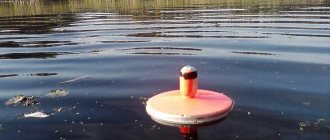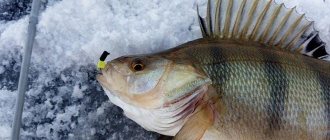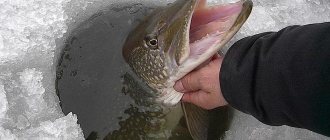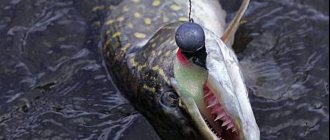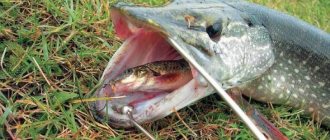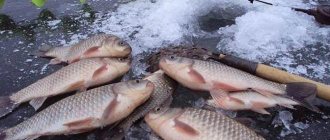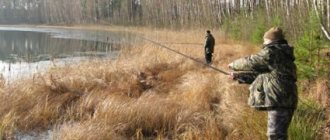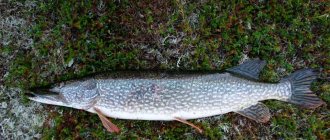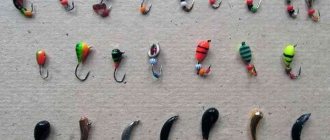Pros and cons of catching pike on girders
The advantages of early winter pike fishing with girders are as follows:
- high fishing efficiency. At the beginning of winter, pike are active and respond well to live bait;
- the opportunity to catch more passive pike, which does not want to peck on artificial baits;
- the possibility of fishing in shallow water and in hard-to-reach areas, where fishing with artificial bait is unpromising;
- the excitement of fishing with girders, when the angler can see with his own eyes the moment of a bite, react to it in time and compete with strong fish.
But fishing with girders is not without some disadvantages:
- low mobility. Changing fishing locations takes a lot of time;
- difficulties of fishing in severe frost, because, despite all the tricks, the hole quickly freezes;
- the bulkiness of gear, which takes up a lot of space in a fisherman’s equipment;
- the inevitable difficulties of fishing with girders in strong winds or snowfall. Most designs of girders are unstable in a strong wind, and in a snowstorm the girder can be covered with snow so that it will not only be possible to see the bite, but also to find the tackle itself.
Pike behavior on first ice
In winter, these predatory waterfowl are not based in one place, but constantly move in the reservoir. Therefore, it will not be possible to fish in the same place until spring. True, there is a certain pattern in the movements of the catfish, which makes it easier for fishermen to search.
Fishing professionals note that the pike bite on the first ice is better where there is more food. Before wintering, the fish strives to be as full as possible and grazes in water areas where there is such an opportunity.
Pike often chase schools of perch. If you are lucky enough to find stripers, there is a high probability of finding a pike nearby.
It is worth noting that the behavior of pike at the beginning of the opening of ice fishing is very different from the subsequent one. At first, the predator experiences discomfort from a change in its usual living conditions. But after acclimatization, it begins to actively grab the bait. The predator goes hunting twice a day. Unlike the deep winter, when the fish becomes passive, in the first ice it reacts to the bait even from a long distance and rushes.
The phase of excessive activity of the toothed predator lasts 10-14 days from the beginning of the formation of ice cover on the reservoir. At this time, there is also an abundant bite. The intensity of the bite decreases as the underwater vegetation (fish food supply) dies and the oxygen level in the water decreases.
Time
Times of Day
The first ice is traditionally considered the best time for catching pike; later, with the deterioration of the oxygen regime, it becomes sluggish and the fisherman has to devote more time to searching for the predator, setting up the gear correctly and hoping for luck.
Pike can actively feed during daylight hours, although it is believed that morning and evening hours are more favorable for fishing. Often pikes are caught on girders left overnight, although the question remains open: whether they bite in complete darkness or are caught in the twilight.
Weather
Favorable conditions for pike fishing are:
- stable atmospheric pressure within normal limits;
- slight frost or thaw;
- light precipitation;
- overcast weather.
In cloudy weather , pike can be caught regularly throughout the day, whereas if the sky is clear, then it is better to count on morning and evening bites.
The influence of weather on the bite
Pike bite well in cloudy weather during the thaw. When the snow melts, the water is enriched with oxygen, which helps activate the fish. The bite is negatively affected by high pressure in the atmosphere and severe frost. To start hunting for toothy fish, you need to move to the place while it is still dark in order to begin to act at dawn. Catching pike on the first ice using various artificial baits is just as exciting as in open water with a regular spinning rod. In winter, the success of fishing is the choice of parking, tackle and bait. Only when going out on ice that has not yet hardened, you must observe safety measures.
Varieties of girders
Subglacial
An under-ice vent or supply is a rather primitive device. The stand is made of plexiglass, porous rubber or other sinking material. One end of such a pole is tied to a stick, which lies on the surface of the ice across the hole. At the other end there is a slot in which the end of the fishing line wound around the girder is secured.
The advantage of this rig is that it takes up little space in a fisherman’s box or backpack, but it is impossible to see the moment of a bite when using such a rig.
Nagladnaya
There are several designs of over-ice vents.
Platform
Gears with a base or platform can be bought at a fishing store or made with your own hands. Such gear consists of the following elements.
Base
The base or platform can be round or rectangular and made of plastic, plywood or foam. Other elements of the girder are attached to the platform; there is a slot for fishing line on one edge. The advantage of such a girder is that it completely covers the hole.
In this case, the hole does not freeze longer, and a light spot does not appear under the hole, scaring away the pike. Among the disadvantages of this design, one should note its bulkiness, low reliability due to the large number of parts, and the fact that the platform often freezes into ice, which leads to damage when removing the girder.
Rack
The stand is used to mount the reel. On factory reels it is made of plastic; those who make reels with their own hands often use metal parts.
Bite alarm
The bite alarm is attached to the platform and is made of elastic wire or a clock spring. The signaling device fixes the fishing line on the reel, and when the fishing line is pulled off during a bite, it gives a signal to the fisherman, since at its end there is a piece of brightly colored fabric - a flag. The alarm must be adjusted so that the live bait cannot force it to go off, but at the same time, the pike will not feel resistance when biting.
Coil
The reel is used to store fishing line. When fishing in shallow water, a supply of fishing line of more than 5-7 meters is rarely required, and if there is a possibility that the pike will go into snags, then this amount of fishing line may be unnecessary.
fishing line
To catch pike in winter on girders, use monofilament fishing line with a diameter of 0.3-0.45 mm, depending on the size of the intended prey. The fishing line is tied to a swivel with a clasp.
Sinker
The girders are equipped with a sliding lead sinker, usually shaped like an olive.
Leash
The most reliable option when catching pike on a girder is a metal leash. It should be made of soft leader material so that the movements of the live bait are not hampered.
Hook
To catch pike on girders, double or triple hooks are used. The live bait is attached to the double as follows: a loop of the leash is inserted under the gill cover and brought out through the mouth. Then a double is put on the loop.
Live bait is practically not injured, although sometimes the pike does not have time to completely swallow the bait, sensing something is wrong. The live bait is placed on the tee by piercing the back under the dorsal fin.
Expert opinion
Knipovich Nikolai Mikhailovich
Zoologist, hydrobiologist. I am interested in fishing at a professional level.
Important! When fishing with girders, you must have a hook to pull the prey out of the hole. For pike fishing, you should use ice screws with an auger with a diameter of at least 150 mm.
Tripod
The tripod holder takes up less space, but is extremely unstable in the wind. In addition, an uncovered hole freezes quickly.
On a pole
Although the pole-mounted pole is more stable in the wind, it is quite difficult to install in the absence of snow on the ice. The hole also freezes quite quickly.
With your own hands
Many fishermen prefer to make girders with their own hands.
In order to make a vent at home, you will need the following tools and materials:
- pliers, wire cutters, hacksaw;
- plywood or rigid foam;
- elastic wire or clock spring;
- metal corner or tube;
- bicycle spoke;
- rivets, screws, bolts;
- empty fishing line spool;
- brightly colored fabric;
- line, sinker, swivel, hook.
The vent is made as follows:
- the base is cut out from available material;
- a metal stand and a bite alarm are attached to the base;
- using a bracket made from a bicycle spoke, attach the reel to the stand;
- the signaling device is equipped with a flag;
- make the actual equipment.
Detailed description of equipment
Many people are concerned about the issue of equipping a girder for pike in winter. How to do this correctly can be clarified by more experienced colleagues. Also, a lot of useful information is available for free use on the Internet.
The amount of line that is wound onto the reel is determined by the location where the fishing takes place. It is quite advisable to wind 25-30 meters of monofilament fishing line with a cross-section of 0.25-0.40 mm onto a reel.
A thicker nylon model is ineffective because it makes the tackle look rough and clumsy. However, it is better to avoid very thin fishing lines, because they worsen the strength indicators and interfere with catching large prey. Braid is not used for winter fishing, which is due to its ability to absorb water and freeze when exposed to sub-zero temperatures.
When rigging a girder, it is customary to use a sliding sinker. As a rule, it has the shape of an olive and is fixed on the main cord above the leash. Weight is determined by the depth and intensity of the current in a particular place. The main thing is not to use sinkers that are too heavy: if they feel resistance, the pike may get scared and release the bait from its mouth.
https://youtube.com/watch?v=C56uH46KlUY
Suitable harness leash
An important element of the harness equipment is the leash, which is attached to the main fishing line and has a length of 20 to 70 centimeters. As for the suitable material for making a fishing leash, fishermen have a lot of disagreements, because everyone defends their preferences.
Experienced fishermen use only steel products, which is due to their reliability and durability. Even the most ferocious and greedy toothed hunter will not be able to bite through steel with her teeth. But due to its impressive size and characteristic shine, such a leash can scare away fish, negatively affecting the intensity of bites.
Therefore, more modern fishing masters use fluorocarbon options, which are especially effective for reservoirs where pike are capricious and react warily to bait. Fluorocarbon withstands intensive use and retains its strength.
Another group of anglers prefers monofilament leashes. To minimize cuts from pike teeth, this line must be folded in half, twisted using the pigtail method and secured with a knot. And although its wear resistance is lower than that of steel, this is quite enough to catch a 5-7 kg pike.
The most catchy live baits
It is no secret that winter pike exhibit capricious behavior, remaining very passive. Therefore, in order to attract a toothy predator and force it to bite, you need to choose the right bait. It is advisable to use those types of fish that are found in the reservoir where fishing takes place. Perhaps it:
- Crucian carp.
- Roach.
- Guster.
- Okunek.
- Ruff.
- Goby.
It is not difficult to catch such a fry using a regular winter fishing rod with a jig. When choosing a suitable live bait, you need to make sure that it meets the following requirements:
- An acceptable size that pike will like. It is useless to use prey that is too large, because it is unlikely to interest an already lazy predator. But small specimens will be very tempting for her.
- Demonstrate a beautiful and attractive game. The fish needs to remain mobile for as long as possible. Any unnatural behavior will greatly alarm the pike and force it to go deeper. Live bait should not fall asleep on the hook, otherwise the angler will have to often take the equipment out of the water and reload it.
To store live bait, it is advisable to use spacious plastic or foam containers, periodically throwing in bloodworms or chopped worms. If you approach this issue correctly, the bait will remain alive for a very long time, maintaining activity and quality.
Tactics and technique
Fishing tactics involve searching for promising pike sites. You can catch it where summer fishing has been successful or focus on other anglers. A trial placement of the girders can be done from the shore to the middle of the reservoir, and if you notice a tendency in the bite, place the non-working girders closer to the catchable ones.
The fishing technique includes the following components:
Bite
A bite is expressed by the alarm going off, i.e. in a flag flying upward. Then the pike reels in a few meters and stops, turning the bait around to swallow it. After this, the line begins to reel in faster, as the predator leaves the bite site.
Sweeping
Hooking should be done after stopping, when you can expect that the pike has swallowed the bait.
Fishing
Fishing should be done patiently, allowing the predator to tire. When approaching the hole, the pike can see the light and make a dash, so the hole should always be shaded.
